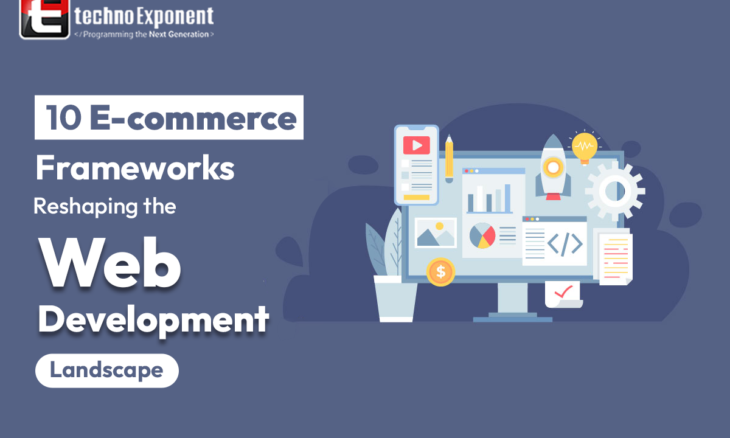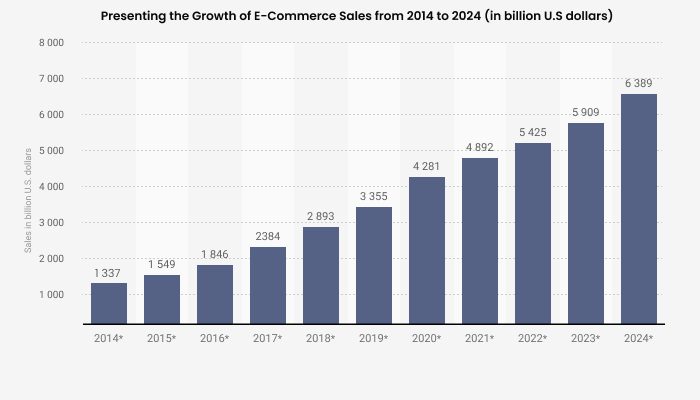
According to the research done by eMarketer and Statista, online retail sales can grow $6.51 trillion by this year. This data shows clearly the increasing need for a scalable and agile e-commerce site in the coming years. However, when you think to contact an e-commerce development company to develop an e-commerce platform, getting an idea of different e-commerce frameworks is advisable. Take a look.

Definition of e-commerce Frameworks
E-commerce frameworks of platforms denote the used software that developers use to build an e-commerce site. They can be considered the base of a website that runs several features in a website. A few of these are architectural features, compatibility with the design and development, functionality of the website infrastructure, operational functionality, and so on. The proper use of frameworks offers the benefits like reduced programming errors, excluding repetitive programming codes, offering the capacity to do advanced tasks without giving a lot of time, etc.
Different Types of E-commerce Frameworks
Several E-commerce frameworks are there that suit the unique need of different projects. Three popular types of e-commerce frameworks developers us rapidly include:
- SaaS
- Open-source
- Headless e-Commerce
SaaS
SaaS is also known as “ software as a service ” It denotes a pricing structure that allows paying the customers for software recurrently. Businesses that are scaling rapidly can get benefitted from the best pricing. SaaS comes with different excellent functionalities. Third-party providers host SaaS.
The benefits of SaaS
- Software improvement options over time are available that help vendors to do real-time upgrades.
- Ownership cost is lesser than the headless or open-source frameworks.
- Easier access to the market. You can save from the hosting burdens as maintenance and security costs are included.
Open-source
This software enables access and changes in the source code. PHP is the programming language used for creating open-source ecommerce platforms. Best customization options within the available budget get possible using it. This type of e-commerce p software is a preferable option for enterprise-scale businesses that work with in-house designers or developers.
Benefits of Open-Source Software
- You get the best solutions from a vibrant community of developers
- Access to a number of customization opportunities are available
- Open-source software is also cost-effective.
Headless e-Commerce
It denotes a system that decouples back and front-end that helps retailers to find their required presentation layer for offering an engaging customer experience. You can also get the multi-vendor approach that enables you to use one solution on the back and one on the front. The decoupled approach offers freedom and control over a project, allowing one to handle any software independently.
Benefits of Headless e-commerce
- You will be able to create a flexible frontend
- Decoupled front and backend reduce the risks of creating any impact on each other.
Must-Have Features of E-commerce Frameworks
Focus on Enhanced Security
Online sites have always been soft targets for hackers, and this condition will be the same in the future. So, keeping your customers’ data safe is a big challenge now. And to do it successfully, you need to focus on the security aspects. So, security can be considered the key element of an e-commerce site. Security features vary from one to another framework.
For instance- SaaS headless e-commerce provides good security. And when you use any open-source software, security controls should be handled by yourself.
A secured e-commerce framework needs to go through these security practices. A few of them include SSL/HTTPS support, PCI-DSS compliance, and data security tools. For each of them, vendors need to go through a hard testing process. Data security tools over there help to block suspicious transactions and intrusion attempts by using third-party software or naively.
Support for Mobiles
These days, the shopping tendency among buyers using mobiles is increasing. So, an e-commerce framework is supposed to offer satisfactory shopping across different devices. Hence, choose a framework that can offer simplistic and user-friendly checkout options.
Product Management
Products are the keys to any business and for this reason, it is significant to ensure convenient product adding or information tracking. Many e-commerce frameworks are available that offer a high-level viewing experience starting with product images, and names to variations.
Top E-commerce Frameworks
BigCommerce
It is a highly flexible SaaS platform with different core platform components which help in creating a connection or extension to any other environment BigCommerce comes with round o’clock availability and gives support for the product launching or store maintenance whenever needed. In-built Industry leading sales functionality is a great quality of this framework.
It helps to save costs and sets this apart from other varieties of frameworks. Also, abandoned cart server functionality is available that lets the customers know about the products that returned to the stocks. Customer support over there gives the quickest response to the customers’ queries creating the best convenience for them.
Another good thing about this framework is, you have options to add product variations upto six hundred. So, if you are including a product with different variations, BigCommerce is a good option you may choose.
Magento
You can deploy magneto on the server on the PaaS. Besides flexibility, Magento is popular for its scalability. A vibrant community of experienced developers work on Magento development.
For using Magento, you don’t need to come with deep technical expertise. Nearly 200,000 website developers have counted on this platform and you can build your own using this. Two Magento versions are available, including Magento commerce and open-source. The e-commerce version was developed to help large-scale businesses, and the open source suits the needs of small-scale e-commerce companies.
WooCommerce
It denotes a self-hosted and open-source framework suitable for WordPress sites. To transform your WordPress site into an e-commerce site, WooCommerce can be used. This platform has the basic features of an e-commerce site you can check out. Here you can expect total control over the customization or the store management of its open-source nature.
It is a preferable option for ecommerce merchants for the reasons like cost-effectiveness, full control over data, enhanced security, easy search engine optimization, etc.
Shopify
Shopify is a good option to choose for building a site with some unique and basic functionalities. Shopify provides an easy store setup and management. The Availability of different templates, user interfaces,and a wide range of integration libraries makes it a go-for option for many business owners. Easy using options is one of the USPs of shopify.
Volusion
One of the worth-mentioning contenders in the e-commerce sector is this one. Since 2000 it has helped many leading e-commerce companies to build great sites. It features a composed architecture for e-commerce with shopping cart options. The shopping cart over here comes with a mix of SEO tools and core e-commerce elements that give a comprehensive solution for beginners.
Wix
This framework was designed specifically for small -scale businesses. Drag and drop features and easy-using options are two worthy features of Wix. You can use this site builder for domain name registration, site hosting, and template customization. Basic website building using Wix can be done free of cost. But for an e-commerce site development, you need a plan to upgrade.
OpenCart
Store management features compatibility with more than 20 payment gateways, and render support for different shipping methods are some worthy features of OpenCart.
This new bee in the framework world has got popular already and 4000 live sites were made already. Downloading and using openCart is free but for its enhanced functionality, paying for addons or plugins are needed.
Squarespace
Squarespace, a demandable SaaS framework provides a convenient and easy site update option and comes with several inventory tools and template designs. There’s no need to involve any third-party developer or engineer when you choose it. To make the most use of Squarespace, checking all its functionality thoroughly is essential.
Zen Cart
It is another highly used and user-friendly platform for developing e-commerce sites. Integration of several payment gateways is available in Zen Cart and you can get access to the community-contributed payments modules.
Kibo
This developer-centric framework is a little bit more complex than the other frameworks. This framework’s prime aim is to offer users a personalized user experience. API-first microservice model was used to create Kibo.
Which Would be the Right Fit for You?
So, after checking those lines now you get an idea about some of the top-grade e-commerce frameworks. Each one of them has some pain points and caters to different business needs. Now, you might be thinking how can you choose the best one among so many overwhelming options? However, to select the right one among them, consider these key factors.
Consider your business type
According to the business models, your selection will vary. While you have a B2B business, select the frameworks like WooCommerce, OpenCart, Magento, etc. Also, consider your selling and select one your chosen framework will help you to sell the intended products easily.
Don’t Forget about Future Growth
You should think beyond today for the best business growth. Hence, be sure to look for future prospects in your framework. Make sure using the right framework you will be able to build a site that will bring more traffic and support international grade compliance and regulations, options for shoppers worldwide to pay in their own currency, etc.
Check Budget
Keep your budget in mind while selecting any e-commerce framework. A SaaS framework would be the right alternative if you prefer a consistent cost. Go for open-source frameworks if you can pay licensing and implementation costs.
Costing of the headless frameworks will vary according to the devices you are integrating them with and your front or backend framework choice.
Final Words
It’s better not to take the selection decision overnight. Instead, try to invest in the right framework and hire e-commerce developers after thoughtful research. After that choose a framework that suits best your budget, requirements, and business goals. And if you have a hard time in choosing the proper e-commerce framework, contact a reputable e-commerce development company with web consultants who have immense knowledge. They will analyze the tech needs of your business and suggest the best-fitted framework for you. It can turn out to be a win-win situation for you.
 +44 141 628 8980
+44 141 628 8980
 (786) 269-2247
(786) 269-2247
 +61 872007153
+61 872007153
 +91 8900027268 (Sales only)
+91 8900027268 (Sales only)







